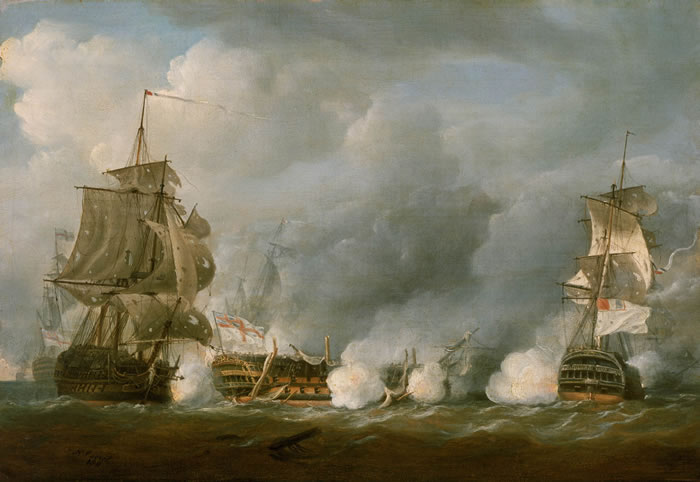HMS Defence (1763)
.
HMS Defence was a Common Class of which its offshoot was the Ballona Class 74-gun third-rate ship of the line, ordered on the 13th of December 1758, designed by Thomas Slade, and built by M/shipwright Thomas Bucknall until the May of 1762. Completed by Israel Pownoll she was launched on the 31st of March. 1763 at Plymouth Dockyard.
History Great Britain Name: HMS Defence Ordered: 13 December 1758 Builder: Plymouth Dockyard Launched: 31 March 1763 Fate: Wrecked, 24 December 1811 Notes: General characteristics Class and type: Bellona-class ship of the line Tons burthen: 16038⁄94 (bm) Length: 168 ft (51.2 m) (gundeck) Beam: 46 ft 9 in (14.2 m) Draught: 21 ft 6 in (6.6 m) Depth of hold: 19 ft 9 in (6.0 m) Sail plan: Full-rigged ship Armament:
Career.
She was commissioned on the 19th of October 1770 as a guardship until the May of 1771.
Recommissioned at Chatham for Channel service,during the American War of Independence, Defence served with the Channel Fleet, seeing action at the Battle of Cape St. Vincent in 1780. She was sent out to India in early 1782 as part of a squadron of five ships under Commodore Sir Richard Bickerton, arriving too late for the battles of that year. But in 1783 she took part in the last battle of the war, at Cuddalore. She returned to England at the end of 1785. She was then laid up during the years of peace until the outbreak of the French Revolutionary Wars.
Recommissioned into the Channel Fleet in 1793 under Captain James Gambier, she fought at the Glorious First of June in 1794, distinguishing herself in action against Mucius and Tourville, and becoming one of only two British ships to be completely dismasted in the battle.

HMS Defence at the Battle of the Glorious First of June 1794, dismasted and with severe injury to the hull. Painted by the artist Nicholas Pocock
After repairs, she was sent to the Mediterranean in the May of 1795 under Captain Thomas Wells, joining Admiral William Hotham in time to take part in the Battle of Hyeres in the July of that year.
* In 1798 she came under the command of Captain William Brown, and then on the 6th of May of that year returned to the Mediterranean under Captain John Peyton, taking part in the Battle of the Nile on the first of August.
During 1799 she was commanded firstly by Captain Thomas Stephenson, and then by Captain Lord Henry Paulett at the blockade of Cadiz and Brest.
On 1 July 1800, Defence, Fisgard, Renown and the hired armed cutter Lord Nelson were in Bourneuf Bay when they sent in their boats to attack a French convoy at Île de Noirmoutier. The British destroyed the French ship Therese (of 20 guns), a lugger (12 guns), two schooners (6 guns each) and a cutter (6 guns), of unknown names. The cutting out party also burned some 15 merchant vessels loaded with corn and supplies for the French fleet at Brest. However, in this enterprise, 92 officers and men out of the entire party of 192 men, fell prisoners to the French when their boats became stranded. Lord Nelson had contributed no men to the attacking force and so had no casualties.
In 1801, Defence sailed to the Baltic under Captain Lord Henry Paulet with Admiral Hyde Parker's fleet. She was present at the Battle of Copenhagen, but did not see action as she was part of the reserve under Parker.
She next sailed for the West Indies, but saw no action, returning to England to be paid off in 1802. Refitted at Chatham, she was recommissioned in the May of 1803 under Captain George Hope firstly in the North Sea and thence to Cadiz.
In 1805 she saw action again at the Battle of Trafalgar, where still under Captain George Johnstone Hope, she was positioned in the Lee coloumn and went on to captured the San Ildefonso and fought the Berwick, suffering 36 casualties of which seven were killed and 29 wounded.
Following her return from the battle, she was paid off again in December for a large repair which took from May 1806 until the January of 1807 to effect. on the completion she was recommissioned under Captain Charles Ekins for the Channel once more.
She took part in the Copenhagen expedition during the August of 1807,and later on the blockade of Cadiz during December.
Loss.
The beach near Thorsminde
In 1809 she was dispatched under Captain David Atkins for North sea and Baltic service.
On the 24th of December,1811 she ran aground off the west coast of Jutland, Denmark. She was still under the command of Captain Atkins and in the company of the St George, under Rear-admiral Robert Carthew, Reynolds, and Cressy, when a violent gale and heavy seas came up. St George was jury-rigged and so Atkins refused to leave her without the Admiral's permission. As a result, both were wrecked on Laland Island near Ringkobing.
The last cruise.
Defence lost all but 14 of her crew of 597 men and boys, including her captain. St George also lost most her crew entire, including her Admiral. Most of the bodies which were washed ashore were buried in the sand dunes of Thorsminde, which have been known, ever since that event, as " The Dead Mens' Dunes".








Bookmarks